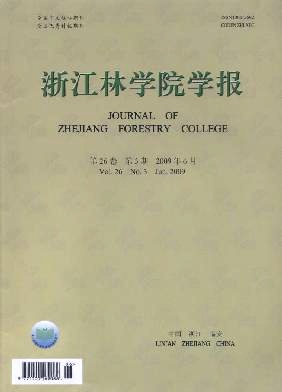| [1] |
ZHENG Yingmao, LIU Juan, PAN Chengchun, LI Chenghui, HUANG Bangwen, DING Ping, LIU Julian.
Analysis of avian composition characteristics in Jiulongshan National Nature Reserve
. Journal of Zhejiang A&F University,
2020, 37(6): 1167-1176.
doi: 10.11833/j.issn.2095-0756.20190737
|
| [2] |
BAI Tian, HE Yeyan, GAO Xulong, ZHAO Ayong, HE Ke.
Non-invasive sampling and mitochondrial genome analysis in Python reticulatus
. Journal of Zhejiang A&F University,
2019, 36(3): 444-450.
doi: 10.11833/j.issn.2095-0756.2019.03.003
|
| [3] |
XU Xingjun, TIAN Jinbo, WANG Youxiang, WANG Qinghui, XUE Mingqiang, SHAO Shuli, WANG Weiyu, ZHANG Weiwei, LI Xuyan.
Food composition differences influencing tree sparrow energy metabolism and its digestive tract structure
. Journal of Zhejiang A&F University,
2018, 35(2): 347-354.
doi: 10.11833/j.issn.2095-0756.2018.02.020
|
| [4] |
YANG Xiaolan, GONG Hede.
Seed predation by rodents in northwest Yunnan Province
. Journal of Zhejiang A&F University,
2015, 32(3): 440-445.
doi: 10.11833/j.issn.2095-0756.2015.03.017
|
| [5] |
ZHENG Yanxia.
Winter habitat selection for elliot's pheasant in Guanshan National Nature Reserve,Jiangxi Province
. Journal of Zhejiang A&F University,
2014, 31(1): 89-96.
doi: 10.11833/j.issn.2095-0756.2014.01.014
|
| [6] |
RUAN Jiajia, YUAN Jinqiang, YANG Xianyu.
Cloning and sequence analysis of claudin-4 cDNA from Bufo japonicus formosus
. Journal of Zhejiang A&F University,
2013, 30(4): 561-566.
doi: 10.11833/j.issn.2095-0756.2013.04.016
|
| [7] |
SONG Minguo, YUAN Jinqiang, YANG Xianyu, ZHANG Shufang, ZHUGE Hui, XU Yue.
Cloning and sequence analysis of prothymosin-α cDNA of Bufo japonicus formosus
. Journal of Zhejiang A&F University,
2013, 30(3): 401-405.
doi: 10.11833/j.issn.2095-0756.2013.03.016
|
| [8] |
XU Wenhui, YUE Xiaolei, GAO Peng, XIA Shujuan.
Potential ecological habitat of Muntiacus crinifrons within National Nature Reserve of Mount Tianmu,Zhejiang Province
. Journal of Zhejiang A&F University,
2013, 30(6): 896-903.
doi: 10.11833/j.issn.2095-0756.2013.06.014
|
| [9] |
YU Yun-wei, YING Ye-qing, REN Li-ping, HU Jia-fu, ZHAO A-yong.
Community structure and biodiversity of soil animals in bamboo stands of Lin’an,Zhejiang
. Journal of Zhejiang A&F University,
2012, 29(4): 581-587.
doi: 10.11833/j.issn.2095-0756.2012.04.015
|
| [10] |
XU Yue, SONG Min-guo, YANG Xian-yu, YUAN Jin-qiang.
The galectin-3 cDNA diversity and amino acid variation of Bufo gargarizans skin tissue
. Journal of Zhejiang A&F University,
2012, 29(4): 574-580.
doi: 10.11833/j.issn.2095-0756.2012.04.014
|
| [11] |
LIU Mi-lan, LI Ming-yang, WANG Xiao-jun.
Impact of rapid transportation network on the potential habitat of Hydropotes inermis in suburban areas
. Journal of Zhejiang A&F University,
2012, 29(6): 897-903.
doi: 10.11833/j.issn.2095-0756.2012.06.014
|
| [12] |
WANG Rong.
Principal component analysis and evaluation of waterfowl habitats along the coastline of Fujian Province
. Journal of Zhejiang A&F University,
2011, 28(3): 472-478.
doi: 10.11833/j.issn.2095-0756.2011.03.020
|
| [13] |
ZHU Xi, WANG Qing-liang, ZHAN Yin-bo, HAN Pu, JIANG Hong-yun, ZHOU Wen, HE Yu-bo.
Fauna and distribution of amphibian and reptile on Putuoshan Island,Zhejiang
. Journal of Zhejiang A&F University,
2009, 26(5): 708-713.
|
| [14] |
SHAO Ji-feng, LU Qing-bin, JIN Jing, YOU Wei-yun, YU Jiang-ao.
Winter feeding site selection of ring-necked pheasants in Mount Qingliangfeng
. Journal of Zhejiang A&F University,
2008, 25(4): 507-512.
|
| [15] |
ZHU Gui-shou, DING Liang-dong, YU Gen-lian, ZHOU Xiao-li.
Wildlife domestication and propagation industry in Zhejiang Province
. Journal of Zhejiang A&F University,
2008, 25(1): 109-113.
|
| [16] |
ZHANG Zong, LIANG Nan-nan, GUO Yu-dong, ZHAO Jun.
Diversity of landscape architecture approach in city birds protection
. Journal of Zhejiang A&F University,
2007, 24(4): 511-515.
|
| [17] |
PANShi-xiu, MEN Xiu-xiang, FENG Jin-chao, ZHOUYi-jun, XUHong-fa.
A review of studies on habitat selection by small and solitary forest ruminants
. Journal of Zhejiang A&F University,
2007, 24(3): 357-362.
|
| [18] |
CAOMing, LI Wei, ZHOUWei, ZHANG Xing-yong, ZHANG Ren-gong.
Foraging sites during the early breeding stage of Syrmaticus humiae in the Nanhua Part of Ailaoshan National Nature Reserve
. Journal of Zhejiang A&F University,
2007, 24(2): 203-208.
|
| [19] |
YANG Qiong-xia, YIN Shu, SHENTU Yin, GAO Xin, SUN Yi, HU Jun-xiang.
Radioprotective effects of extract from Carya cathayensis nut exocarp on mice
. Journal of Zhejiang A&F University,
2006, 23(6): 604-607.
|
| [20] |
LI Wei, ZHOU Wei, JI De, ZHANG Ren-gong.
Habitat use of Syrmaticus humiae in Nanhua Part of Ailaoshan National Nature Reserve in spring
. Journal of Zhejiang A&F University,
2006, 23(2): 153-158.
|









 DownLoad:
DownLoad: